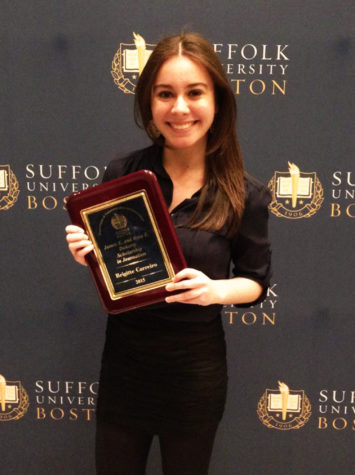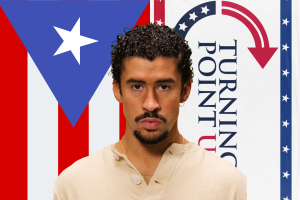Mobility, economy increase international undergraduates
Worldwide education influx spreads across nations
April 6, 2016
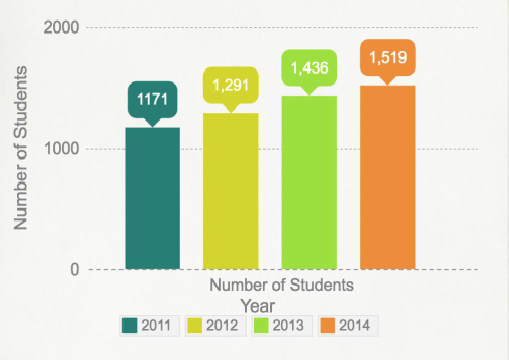
Suffolk’s international student population has been on the rise for the past four years, growing to just shy of 1,600 last semester compared to barely 1,100 during the Fall 2011 semester, an increase due to a heightened mobility among international students.
Tracy Fitzgerald, assistant director of the International Student Services Office, has worked with Suffolk since 2009 when, according to her, there were just about 800 international students enrolled at the university. She attributed the recent increase to a realization among international families that the advantages of an education abroad are unbeatable.
“More and more students and families are entering into a place where, economically, they can afford to send their children overseas. They see the value of an international education,” she said. “They also want their children to have a competitive edge, so the idea of being educated abroad and then returning to the home country is a certain advantage when it comes to looking for jobs.”
Director of the Center for International Programs and Services, Kathleen Sparaco, added that the trend of an increased international population at Suffolk is a national one, as there has been a 50 percent increase across the country since 2007. The United States houses the largest number of international students, according to her.
“The U.S. tends to be a very big draw,” she said.
Suffolk sees the highest number of these students coming from China and Saudi Arabia, as Chinese enrollment has gone from 235 in 2011 to 357 in 2014 and Saudi Arabian enrollment has seen quite a jump as well: 91 in 2011 to 203 in 2015. After these two countries, Venezuela,
Vietnam, India, Mexico, and Spain send the most students to Suffolk.
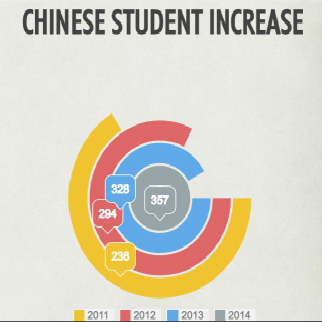
Sparaco said that many students from China go abroad due to a combination of a boost in economy and a lack of infrastructure for their enormous population.
“China has experienced a lot of economic success. Like any country, there are just more and more people to educate. Naturally they’re looking at other countries because their population is huge,” she said. “And while they have some great universities, there’s just not enough spaces, so they do have to find school elsewhere.”
Fitzgerald agreed and said, “It was probably just a matter of time before we saw that demographic increase.”
Saudi Arabia, they said, initiated the King Abdullah Scholarship Program years ago that encouraged an overseas education, attributing to the large portion of Saudi Arabian Suffolk students.
“Now there’s probably about 100-200 thousand Saudis studying in the United States, and there’s more than that studying in other countries around the world,” Fitzgerald said. “They do decide what majors [students can study]; they want to mix it up a little bit so that they bring back a workforce that has variety and has some diversity to it.”
According to the Saudi Arabian Cultural Mission to the U.S., students who take part in the program are required to choose a program of study in areas of health, engineering, business, science, education, digital media, psychology, or hospitality.
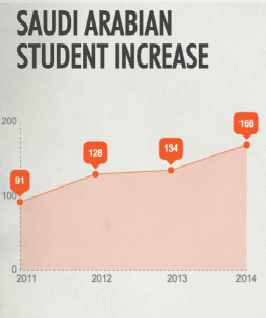
Whether or not these populations will continue to increase, however, is not clear cut. According to Fitzgerald, the Saudi Arabian scholarship is starting to become more limited, and the Chinese economy is slowing down. However, “For every country with a decline, there’s always an increase,” Sparaco said, citing the increasing Brazilian student population at Suffolk.
Although Suffolk does send enrollment managers all over the world, recruitment, Sparaco said, has more to do with connections that students make in the U.S.
“Recruitment is not just people in enrollment management but its connections made through faculty, brothers, sisters, and cousins of alumni,” she said. “Suffolk has a lot of professors who are foreign born or are internationally involved. That, in and of itself, is a recruitment tool.”
According to Assistant Vice President of Enrollment and Director of Undergraduate Admission, Donna Grand Pre, the admissions office spends approximately 10 to 15 percent of recruitment resources overseas.
“We also will allocate more resources or time to certain countries like China, due to the sheer size of the country,” said Grand Pre.
One addition to Suffolk’s large international student population stemmed from the closing of the campus the university operated in Dakar, Senegal. Closed for after a considerable monetary loss due to its upkeep, according to the Boston Globe, Fitzgerald said that students who had been completing their degrees in Dakar made the move to Boston.
“We did have the probably the largest West African population in all the schools in the city of boston, but that is slowly going away because they’re graduating, they’re moving on,” she said.
Indeed, the number of students from Senegal dropped from 60 to under 20 from 2011 to 2014.
“The nice thing is there’s such a legacy of Suffolk over there,” said Fitzgerald. “People still know that name, and still want to come here because they’ve heard about it.”
An Wang, president of the International Student Association, said that the urban campus of Suffolk provides an easy place for international students to explore.
“The city life itself and the opportunities in the area give a new experience for all internationals to explore the heart of Boston,” she said.
She said the environment of Suffolk “requires a bit more effort to connect with other students because Suffolk has a big commuter population, but that makes the effort more valuable.”
Despite common issues that arise from these students studying abroad, including language barriers and difficulty with group work, Fitzgerald highlighted the diversity even among international students at Suffolk.
“If you walk in front of the Sawyer building at class change time on Tuesday or Thursday, do you hear conversation in English? No,” she said. “It’s the UN, and it is absolutely, to me, just one of those breathtaking moments of this being a special place.”
has increased from 235 in 2011 to 357 in 2014 and Saudi Arabian enrollment has seen quite a jump as well: 91 in 2011 to 203 in 2015. After these two countries, Venezuela, Vietnam, India, Mexico, and Spain send the most undergrads to Suffolk.
Sparaco said that many students from China go abroad due to a combination of a boost in economy and a lack of infrastructure for their enormous population.
“China has experienced a lot of economic success. Like any country, there are just more and more people to educate. Naturally, they’re looking at other countries because their population is huge,” she said. “And while they have some great universities, there’s just not enough spaces, so they do have to find school elsewhere.”
Fitzgerald agreed and said, “It was probably just a matter of time before we saw that demographic increase.”
Saudi Arabia, they said, initiated the King Abdullah Scholarship Program years ago that encouraged an overseas education, attributing to the large portion of Saudi Arabian Suffolk students.
“Now there’s probably about 100 to 200 thousand Saudis studying in the United States, and there’s more than that studying in other countries around the world,” Fitzgerald said. “They do decide what majors [students can study]; they want to mix it up a little bit so that they bring back a workforce that has variety and has some diversity to it.”
According to the Saudi Arabian Cultural Mission to the U.S., students who take part in the program are required to choose a program of study in areas of health, engineering, business, science, education, digital media, psychology or hospitality.
Whether or not these populations at Suffolk will continue to increase, however, is not clear. According to Fitzgerald, the Saudi Arabian scholarship is starting to become more limited, and the Chinese economy is slowing down.
However, “For every country with a decline, there’s always an increase,” Sparaco said, citing the increasing Brazilian student numbers at Suffolk.
Although Suffolk does send enrollment managers all over the world, recruitment, Sparaco said, has more to do with connections that students make in the U.S.
“Recruitment is not just people in enrollment management, but it’s connections made through faculty, brothers, sisters and cousins of alumni,” she said. “Suffolk has a lot of professors who are foreign born or are internationally involved. That, in and of itself, is a recruitment tool.”
According to Assistant Vice President of Enrollment and Director of Undergraduate Admission, Donna Grand Pre, Suffolk’s admissions office spends approximately 10 to 15 percent of recruitment resources overseas.
“We also will allocate more resources or time to certain countries like China, due to the sheer size of the country,” said Grand Pre.
One addition to Suffolk’s large international student population stemmed from the closing of the Dakar, Senegal campus the university operated. Closed after a considerable monetary loss due to its upkeep, according to the Boston Globe, Fitzgerald said that students who had been completing their degrees in Dakar made the move to Boston.
“We did have the probably the largest West African population in all the schools in the city of Boston, but that is slowly going away because they’re graduating, they’re moving on,” she said.
Indeed, the number of students from Senegal dropped from 60 to under 20 from 2011 to 2014.
“The nice thing is there’s such a legacy of Suffolk over there,” said Fitzgerald. “People still know that name, and still want to come here because they’ve heard about it.”
An Wang, president of the International Student Association, said that Suffolk’s urban campus provides an easy place for international students to explore.
“The city life itself and the opportunities in the area give a new experience for all internationals to explore the heart of Boston,” she said.
She said the environment of Suffolk “requires a bit more effort to connect with other students because Suffolk has a big commuter population, but that makes the effort more valuable.”
Despite common issues that arise from these students studying abroad, including language barriers and difficulty with group work, Fitzgerald highlighted the diversity even among the international students at Suffolk.
“If you walk in front of the Sawyer building at class change time on Tuesday or Thursday, do you hear conversation in English? No,” she said. “It’s the UN, and it is absolutely, to me, just one of those breathtaking moments of this being a special place.”


